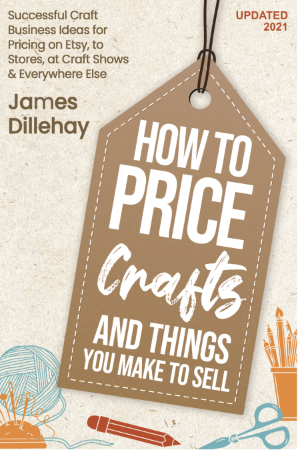How to Price Crafts and Things You Make to Sell
by James Dillehay
One of the most frequently asked questions is “How to price crafts?” This article gives you a basic formula to use for pricing crafts. You will learn how to price when selling retail and for setting wholesale prices.
Cost of Materials
The first step in pricing crafts is to calculate the cost of your materials. Cost of materials should include every little thing that goes into a finished piece. Some items you may have to estimate — like paint or glitter or yarn.
Let’s say you make Christmas ornaments. And let’s say it costs you $2.75 in materials to make one ornament.
Cost of Labor
The next step is figuring the cost of your labor. How much is your time worth? $10/hour, $15/hour, $20/hour or more? Choose the value of your labor. Then, multiply the hourly rate by the hours it takes to make the item. Don’t fudge. You need to know this amount in order to learn how to price your crafts. You will want to earn the maximum profit from each piece.
For example, if it takes 1/2 hour to make a Christmas ornament and your hourly rate is $15, then your cost of labor is $7.50.
Break Even
For our ornament example, add cost of materials ($2.75) to the cost of labor ($7.50). We now have a cost of goods of $10.25. Should the asking price of the ornament then be $10.25? Maybe yes, maybe no. What is certain is that $10.25 is the minimal amount of money you must earn back in this example.
If you want to sell to stores, you can figure that the shop will usually pay you half of the retail amount they charge. So if the store is asking $20, you’ll get $10.
Related post: Pricing Calculator for Selling on Etsy and Anywhere Else
How Much Will Shoppers Pay?
We’ve looked at how to price crafts from the point of view of your costs and what you need to get back. The other part of the equation and the question you should be asking is:
“How much are shoppers willing to pay for my handmade items?”
We used a very basic formula for determining the least amount you must earn back for how to price crafts. But that’s just a starting point. It guarantees you don’t lose money.
To really answer the question, “How to price crafts?” you must learn the maximum amount that people are willing to pay for your item. And do this for the markets you sell in, like craft fairs, selling on Etsy or eBay, at home parties or anywhere else. If you are selling at craft fairs, your prices may be different than it would be for selling to stores or on eBay.
To learn the maximize how to price your craft, you need to do some digging. If you are selling to stores, check out stores that carry craft items like yours and note the retail prices. If you are selling on Etsy, Craftsu or eBay, make a list of items like yours and what their closing bids were.
Continue to research prices for items like yours in the market you sell in over time. If the average market price is lower than your cost of goods, you will lose money. You have to then find other items to make or find a way to lower your costs.
Most Handmakers Under-Price
Most craft artists undercharge. It’s because they imagine that price is why people buy. They think they will sell more by lowering their prices. But this actually works against you.
What really happens is that customers see the low price on the craft and think the item is cheaply made. In many cases, I and others have found that raising prices actually stimulated sales.
Learn more about pricing crafts strategically. Discover how to enhance the perceived value of your items. And find ways to lower your material costs. Buy the book How to Price Crafts and Things You Make to Sell.
_____________________
Related: Discover how to raise prices without losing customers: https://craftmarketer.com/how-to-raise-prices/

